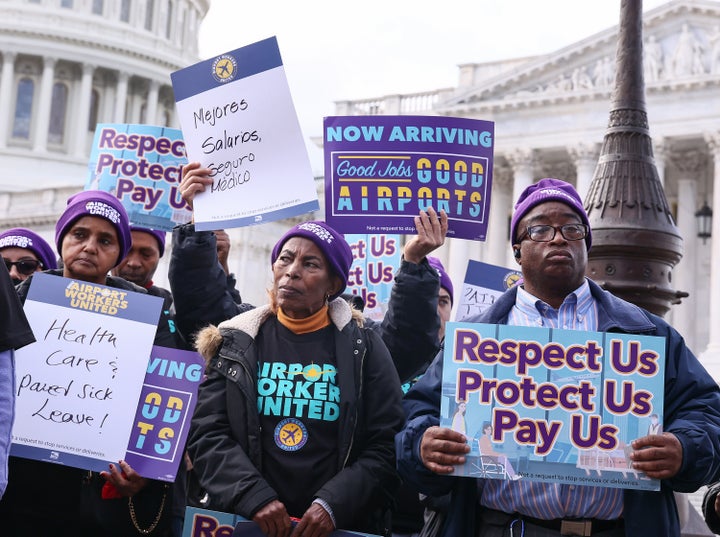When Katherine J. “Katie” Taylor chose Harvard Law School over a full scholarship to the University of Alabama School of Law, she had her sights set on a public interest legal career.
Though HLS would not match the financial aid Alabama offered, Taylor trusted the school would support her ambitions to work a low-paying public interest job through its Low-Income Protection Plan.
Launched in 1978, LIPP aims to reduce the burden of student debt by subsidizing loan repayments for graduates pursuing government, public sector, academic, or other low-income jobs. Participants earning more than $55,000 per year are asked to contribute a limited percentage of their annual income toward monthly loan repayments and receive subsidies from Harvard to cover the rest.
“Through LIPP, Harvard Law School is committed to preserving freedom of job choice within the legal profession for its graduates,” the school’s website reads.
But Taylor — now an immigration attorney for Kentucky Refugee Ministries, a nonprofit — said she may have to reconsider her decision to work in public service because of the financial burden her expected LIPP contributions pose.
Law School students and alumni have long criticized the program, calling for increases in transparency, the number of accepted participants, and the amount of support offered. In 2017, a group of alumni formed the Coalition to Improve LIPP and wrote an open letter to HLS Dean John F. Manning ’82 claiming LIPP fell short of similar programs offered by peer institutions.
In response to calls for reform throughout the last four decades, the Law School has implemented a series of changes to the program, such as boosting allowances for childcare and upping support for transitions between jobs. In May, LIPP saw the most significant reform since its establishment: a 14.5 percent increase in its contribution scale, boosting participants’ calculated subsidies.
But despite these improvements, students and alumni maintain that LIPP fails to sufficiently support graduates pursuing public interest careers. Critics of the program point to its methodology for incorporating assets other than personal income — such as retirement savings, home value, personal savings, and spousal income — into calculations for participants’ expected contributions.
As they navigate post-graduate life, some participants say they feel caged in by the volatility of their LIPP payments — a fear that has factored into decisions about marriage, promotions, and career changes.
“It just feels like in a lot of ways, it has people balancing on the edge of a cliff,” LIPP participant Andrea F. Forsee said of the program.
‘I’m Living Paycheck to Paycheck’
During the Covid-19 pandemic, the U.S. housing market surged, with home prices jumping 45 percent from December 2019 to June 2022. For Taylor, who graduated HLS in 2017, the boom triggered an unexpected drop in LIPP assistance.
In calculating subsidies, LIPP takes into account a participant’s non-income assets, including home equity. After her home value soared from $131,000 to $200,000, Taylor saw her expected monthly contributions rise from zero to nearly $500 despite no change in her income.
“They acted like it was like I had $70,000 of cash, which just was not reality,” she said.
Law School spokesperson Jeff Neal wrote in an email that the program aims to allow participants to report the lowest valuation on their home. LIPP participants are asked to submit the lowest value of their house from one of three major valuation websites during the fall or winter, when the housing market is typically the slowest.
“It would not be equitable to give the same LIPP award to two participants who have vastly different assets, be they liquid or not,” Neal wrote.
But Taylor, a foster parent, says the increase in her monthly payment has pressured her to consider whether to prioritize owning a house or continuing to work in public service.
“Five hundred dollars a month is hard,” she said. “It's hard for me to make work, and I can do it right now, but I don't know how long I can do that for.”
Other LIPP participants similarly voiced concerns about the financial challenges they face as members of the program.
Emmy F. Williams, who graduated from the Law School in 2019, said the promise of post-graduate financial assistance made HLS her “dream law school.” After accepting a clerkship in the U.S. Court of Appeals for the Eleventh Circuit after graduation, however, she “started to realize that LIPP took a lot of [her] salary.”
"I feel that I’m living paycheck to paycheck,” Williams said. “I’m not able to plan for retirement. I’m not able to put savings away.”
Elizabeth S. Feldstein, a 2021 Law School graduate, said her expected monthly contributions to LIPP “doubled or tripled” after she took an entry-level attorney position within the federal government.
“At this point, I think it’s about half of my rent,” she said.
Still, some former LIPP recipients said they were grateful for the program because it allowed them to work in public interest without needing to worry about large law school debt.
Leah A. Plunkett ’01, a former LIPP recipient and the Law School’s Assistant Dean for Learning Experience & Technology, said she paid off roughly three quarters of her law school debt with LIPP.
“I went to HLS in large part because of its LIPP program, and LIPP delivered for me in terms of setting me up for a public service career,” she said.
Mercedes H. Montagnes said LIPP was the only reason she could pay off her loans from HLS as a civil rights attorney.
“There’s no way I would have been able to do the career that I have, with the stability that I’ve had,” she said. “And now my loans are completely paid off.”
Jordi I. Torres, a 2013 graduate of HLS, said he feels “pretty lucky” for the support LIPP offers, but held that the program still has room for improvement.
“Could Harvard do better? Sure, Harvard has a lot of money,” he said. “And so could that go to just better supporting students in public interest? I think that’s always going to be true.”
‘The Crushing Weight’
While graduating from HLS opens the door to public interest legal work, some alumni say LIPP — governed by a web of policies and formulas — presents a barrier to career advancement and personal milestones.
For Forsee, a 2021 graduate of the Law School, LIPP’s policy on spousal income factors into her decision on when to marry her boyfriend, who earns a higher income than she does.
“I'm certainly figuring out marriage and trying to decide when to do that,” Forsee said. “The timing is a lot based on LIPP for me and my boyfriend.”
According to LIPP policies, if a graduate earns more than their spouse, only the graduate’s income is considered in calculating monthly contributions. If a graduate earns less than their spouse, the contributions are based on the pair’s average income after deducting the spouse’s educational loan payments.
Some participants say LIPP’s policies disincentivize marriage and job promotions.
“LIPP gets the benefit when you are married to someone who’s a high earner, but you don't get the benefit if you’re married to someone who’s a low earner or potentially legally unable to work due to immigration,” Laura O. Rockmore, a 2020 HLS graduate, said.
Rockmore participated in LIPP while working as a clerk after law school but subsequently accepted a job “a couple grand” over the income threshold. Asked to pay back the year of assistance she had received, Rockmore said the Law School would not take into account the financial support she provides for her wife, who is unable to work.
“I’m actually having to move out of the city into my parents’ house just because I want to be able to afford a house someday,” she said. “I just don’t really see that happening — just with the crushing weight of the loans and supporting two people and not being able to get any of the assistance.”
“I sometimes wish I’d asked my law firm to give me a lower starting salary because then I could have stayed on LIPP,” Rockmore added.
Neal wrote in an email that loan repayment assistance programs at peer institutions also take spousal income and assets into account, adding that need-based programs like LIPP aim to consider all resources available to a participant.
“It would not be equitable to give the same LIPP award to two participants who have vastly different household incomes,” he wrote.
LIPP’s contribution formulas also struggle to account for unexpected non-discretionary expenses and non-income assets, some participants claim.
Williams said she suffers from a chronic illness that generates “high and unpredictable healthcare costs.” When she approached HLS about the expenses, she said, the school refused her request for adjusted monthly LIPP contributions.
According to the LIPP policies website, the program does not regularly make allowances for out-of-pocket medical expenses, but Neal wrote that HLS considers “extenuating circumstances” when calculating the amount of loan repayment aid offered to a participant each year.
“Not having any savings is very stressful as someone with a disability in case I need to go to the emergency room or in case I need to have a procedure done or things like that,” Williams said.
Some LIPP recipients have also voiced complaints about the program’s restrictions on personal savings. The program allows new participants to maintain up to $10,000 in non-income assets — including personal savings, retirement savings, investment equity, and home equity — that will not factor into expected monthly contribution calculations. For each full year of employment after college, participants receive an additional $10,000 of protected asset allowance.
Molly Prothero, a 2021 HLS graduate, said her year of employment prior to law school was deemed ineligible for additional asset protection. Despite working “well over 40 hours a week,” Prothero did not hold full time employment, only two part-time jobs.
“I had an unpaid internship, and I worked at a restaurant at night,” she said. “But because neither of those are considered full-time jobs, I did not get any asset protection for that year.”
Neal said the Law School offers generous asset protection to LIPP-eligible graduates.
“We are constantly monitoring whether the asset protection allowance is serving eligible graduates, and we make adjustments when needed,” he added.
But Taylor said that since her house equity increased, nearly all of her LIPP contributions result from her non-income assets exceeding the amount protected by the program.
“All the money I have in savings counts 100 percent against me on the asset allowance,” she noted, saying she tries to build up savings for the kids she fosters.
“So you’re saying I make under the income [threshold]? Great,” she added. “Well, then why does it matter whether I spend it or save it?”
‘We’re Not Alone’
Online, more than 600 HLS students and alumni have gathered in a Facebook group called “Living on LIPP” dedicated to sharing information about the program.
Rockmore, a member of the group, said she has seen posts voicing concerns about LIPP “for many, many years,” with some participants struggling to manage child care costs, mortgage payments, or retirement funds.
According to Williams — who is also part of the Facebook group — some Living on LIPP members have done their own calculations to determine “what the sweet spot salary is and how much you can actually take home from a salary increase.”
“People are definitely organizing. They’re coming together,” Williams said. “And I think we’re realizing that we’re not alone in feeling financially stressed.”
Brendan R. Schneiderman, a 2021 HLS graduate, said those advocating for LIPP reform target three main areas for improvement: adjusting the participant contribution scale, changing how assets are accounted for, and decreasing the impact of marriage on LIPP calculations.
“Just imagine what it would be like if Harvard put its money where its mouth was on supporting public interest students,” Schneiderman said. “We would see a radically different school, and we would see a dramatic impact on the legal profession as a whole.”
LIPP recipient Steven A. Palmer added that the program falls short of the Loan Repayment Assistance Program offered by the New York University School of Law, which covers the full debt of graduates who earn salaries below $100,000.
Neal wrote that HLS is one of just two schools in the country to offer exclusively need-based financial aid, adding that the Law School’s spending on financial aid grants has doubled over the past decade. The Law School also recently expanded its Summer Public Interest Fund, a program aimed at allowing students to pursue unpaid or underpaid public interest jobs.
Palmer said he does not recommend HLS for prospective law students who know they want to work in public interest law.
“I would say, for now, you shouldn’t look at Harvard — look at NYU,” he said.
—Staff writer Ryan H. Doan-Nguyen can be reached at ryan.doannguyen@thecrimson.com. Follow him on Twitter @ryandoannguyen.
— Staff writer John N. Peña can be reached at john.pena@thecrimson.com.


.jpg)









